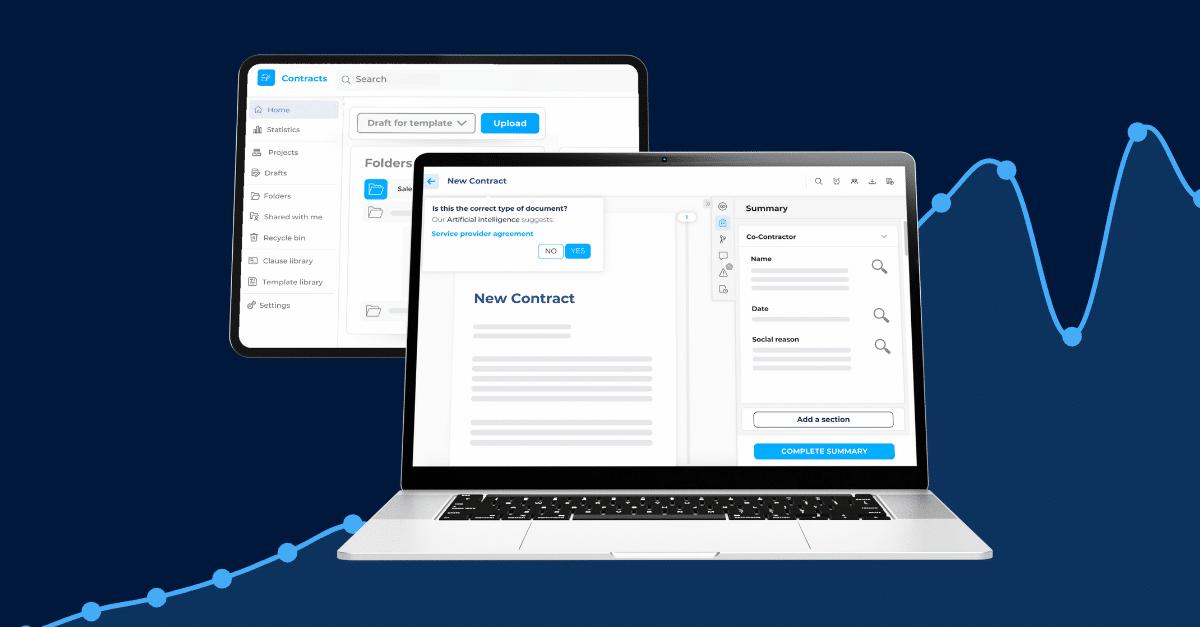Contract negotiation represents a critical juncture in business relationships. Contract negotiation software offers a transformative solution to numerous challenges. The process of creating, reviewing, and finalizing agreements often determines the trajectory of partnerships and financial outcomes. Traditional negotiation methods frequently lead to bottlenecks, delays, and missed opportunities. This comprehensive guide explores how these specialized platforms streamline negotiations, enhance collaboration, and accelerate the path to signed agreements.
Understanding contract negotiation software
Contract negotiation software consists of specialized digital tools designed to automate and optimize the negotiation process. These platforms centralize, within a secure environment:
- Contract creation.
- Revision.
- Approval.
- Execution.
Modern contract negotiation solutions integrate seamlessly with existing contract lifecycle management systems, providing end-to-end visibility and control. They transform static documents into dynamic, collaborative workspaces where stakeholders contribute in real-time.
The core function of negotiation software extends beyond simple document management. Advanced platforms incorporate artificial intelligence to identify risks, analyze clauses, and suggest improvements based on historical data and industry standards.
Common challenges in traditional contract negotiations
Organizations relying on conventional negotiation methods face numerous obstacles which impact efficiency and outcomes.
Fragmented communication channels
When negotiations occur across email threads, phone calls, and in-person meetings, important details frequently get lost. This fragmentation creates confusion regarding the current version of the agreement and which changes have been approved.
Extended review cycles
Without centralized tracking, contracts often languish in review limbo. Legal teams become overwhelmed with revision requests while business units grow frustrated with delays. This disconnect extends negotiation timelines and postpones revenue recognition.
Limited visibility into status
Stakeholders lack transparency into where contracts stand in the negotiation process. This uncertainty complicates resource allocation and planning, particularly for sales teams awaiting finalized agreements before proceeding with implementation.
Inconsistent language and terms
Without standardized templates and clause libraries, organizations risk introducing variations in contract language. These inconsistencies potentially create unfavorable terms or compliance issues which increase exposure to risk.
Benefits of implementing contract negotiation software
Adopting specialized negotiation software delivers substantial advantages across multiple dimensions.
Accelerated time-to-signature
By streamlining the review and approval process, organizations typically reduce negotiation cycles by 50% or more. This acceleration translates directly into faster deal closures and earlier revenue recognition.
Enhanced collaboration
Centralized platforms enable simultaneous input from all stakeholders. Legal teams, business units, and external parties work within a unified environment, eliminating version control issues and facilitating real-time feedback.
Standardized processes
Pre-approved clause libraries and negotiation playbooks ensure consistency across agreements. This standardization reduces risk while allowing for appropriate customization based on specific business needs.
Data-driven insights
Advanced analytics provide visibility into negotiation patterns, identifying bottlenecks and opportunities for improvement. These insights help organizations refine their approach and strengthen negotiating positions over time.
Reduced administrative burden
Automation eliminates manual tasks associated with document creation, comparison, and tracking. This efficiency allows legal teams to focus on strategic matters rather than administrative functions.
Key features to look for
When evaluating contract negotiation software, organizations should prioritize these essential capabilities.
Intelligent clause libraries
Effective solutions maintain repositories of pre-approved language organized by clause type, risk level, and applicability. These libraries accelerate drafting while ensuring compliance with organizational standards.
Redlining and version control
Advanced redlining features enable clear tracking of changes between versions, with automatic comparison highlighting modifications. This functionality eliminates confusion regarding which edits have been proposed or accepted.
Approval workflows
Configurable approval paths route documents to appropriate stakeholders based on content, value, or risk profile. These automated workflows ensure proper review while maintaining momentum throughout the negotiation process.
Integration capabilities
Seamless connections with existing systems – including CRM platforms, document management solutions, and e-signature tools – create an uninterrupted digital experience from initial proposal through final execution.
Security and compliance controls
Robust security measures protect sensitive information through encryption, access controls, and comprehensive audit trails. These safeguards maintain confidentiality while documenting compliance with regulatory requirements.
AI-Powered analysis
Artificial intelligence capabilities review contract language, identify potential risks, and suggest alternatives based on organizational preferences and historical outcomes. This analysis improves agreement quality while reducing review time.
Implementing contract negotiation software: best practices
Successful implementation requires thoughtful planning and execution.
Assess current processes
Before selecting a solution, thoroughly document existing negotiation workflows, identifying pain points and opportunities for improvement. This assessment establishes clear objectives for the implementation.
Secure cross-functional support
Engage stakeholders from legal, sales, procurement, and IT early in the selection process. Their input ensures the chosen platform addresses diverse needs while facilitating broad adoption.
Prioritize user experience
Select solutions offering intuitive interfaces requiring minimal training. Ease of use directly impacts adoption rates, particularly among occasional users such as sales representatives or business unit leaders.
Implement phased rollout
Begin with a limited scope – perhaps a single contract type or business unit – before expanding. This approach allows for refinement based on initial feedback while building momentum through early successes.
Measure and optimize
Establish clear metrics for success, such as reduction in negotiation cycle time or decreased legal review hours. Regular assessment against these benchmarks identifies opportunities for continuous improvement.
For companies seeking to optimize their contract processes, the DiliTrust Governance Suite offers comprehensive contract lifecycle management capabilities within a secure, integrated platform. Its advanced negotiation features help organizations streamline approvals, enhance collaboration, and accelerate time-to-signature.
Ultimately, contract negotiation software transforms a traditionally cumbersome process into a streamlined, collaborative experience. By centralizing communications, standardizing language, and automating workflows, these platforms accelerate agreements while reducing risk. Organizations implementing negotiation software gain competitive advantages through faster deal closures, improved compliance, and more favorable terms.
The resulting efficiency allows legal teams to transition from administrative bottlenecks to strategic business partners. As contract volumes increase and business relationships grow more complex, negotiation software becomes an essential component of effective governance. Forward-thinking organizations recognize this technology as an investment in operational excellence and business growth.
Want to learn more about how DiliTrust can enhance your corporate governance? Contact us today!



